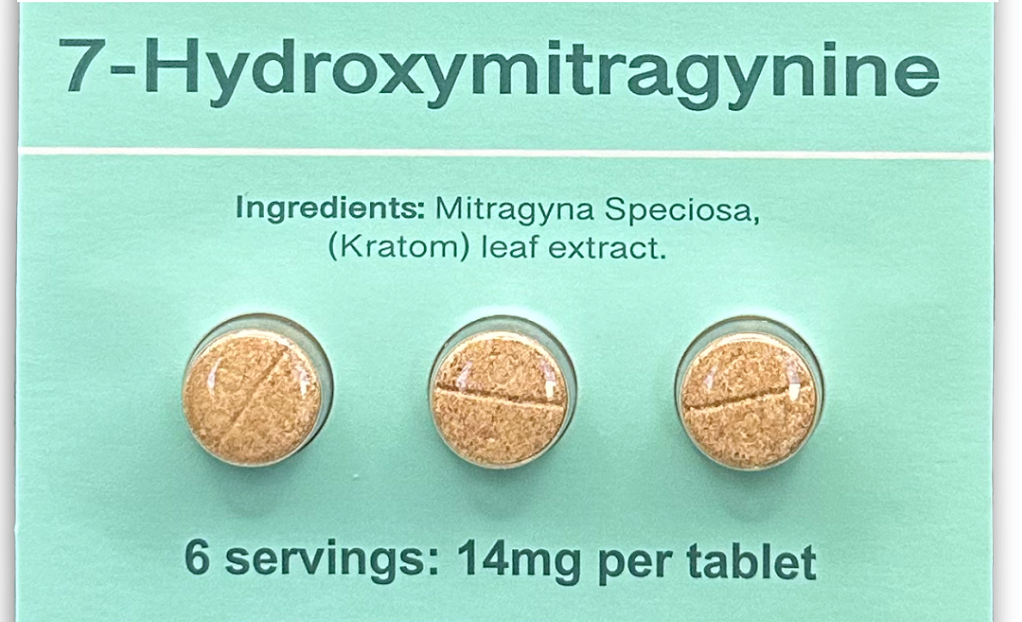
Companies are now selling isolated 7-hydroxymitragyinine in a grey marketplace that the Food and Drug Administration (FDA) refuses to regulate. Found in near-zero amounts in plain leaf kratom, 7-hydroxymitragyinine has been shown in animal studies to have enormous dependency potential.
Obeng et al 2020 demonstrated that while mitragynine, kratom’s most abundant alkaloid, has “a complex pharmacology that combines low efficacy MOR [mu opioid receptor] agonism with activity at nonopioid receptors”, 7-hydroxymitragynine “has 9-fold higher affinity than mitragynine” in vitro. In Hemby et al 2019, 7-hydroxymitragynine, but not mitragynine, “substituted for morphine self-administration in a dose-dependent manner in the rat self-administration paradigm.”
Unlike kratom leaf, 7-hydroxymitragynine has no widespread history of use. Most concentrated kratom extracts have been “full-spectrum”, meaning containing all the alkaloids in the plant, and with 7-hydroxymitragynine occurring only in trace amounts. While 7-hydroxymitragynine could prove to be a beneficial compound, a market infrastructure to deliver enough information to maximize safe use does not exist for kratom, let alone an isolated compound that doesn’t benefit from centuries of traditional consumption. While kratom use has been studied in long term users in Malaysia and Thailand, and consumed by millions of people for hundreds of years, we have no idea about possible side effects of short or long term use of isolated 7-hydroxymitragynine. We have no idea how it will exacerbate a user’s pre-existing health conditions. We have no idea the toxicity, or how it will interact with other drugs, supplements, and foods.
A 7-hydroxymitragynine vendor was kicked out of the CHAMPS Trade Show in Las Vegas in 2023 by event organizers and kratom vendors. A representative of the company was reportedly handing out 7-hydroxymitragynine tablets for free, and was led out in handcuffs for selling a product that’s illegal to sell in Nevada.
Kratom Consumer Protection Acts (KCPA) have language that prevent the sale of kratom products with elevated levels of 7-hydroxymitragynine. It is currently illegal to sell such a product in the 11 states where the KCPA has been enacted: Arizona, Colorado, Florida, Georgia, Nevada, Oklahoma, Oregon, Texas, Utah, Virginia, and West Virginia.
In a 2022 interview with Kratom Science, University of Florida medicinal chemist Chris McCurdy told us that while 7-hydroxymitragynine levels in early kratom products “were all over the place”, in recent years “we’ve seen those levels of 7-hydroxy come way down”.
We should be finding leaf material that has no detectable levels of 7-hydroxymitragynine to start with, because, yeah, we believe that when it’s ingested into the body that the amount of 7-hydroxymitragynine that’s produced from mitragynine is sort of canceled out by the other alkaloids that are present, and that the pharmacological effect is not achievable that you see when you isolate 7-hydroxy by itself.
If we compare 7-hydroxy to the alcohol proof concentration, we want to try and keep that as low as possible so that it doesn’t impair anyone, and it doesn’t help foster abuse potential of the plant.
You shouldn’t be taking kratom to get high. It shouldn’t be a product that’s pushed to so many doses where you get that sort of staggering euphoric effect that most people will puke before they would ever be able to absorb that much to get really high from it. That’s in the traditional method where you don’t have a lot of 7-hydroxy, so that’s why we’ve been so adamant about saying that. If you take it as its pure sanctity product where there shouldn’t be 7-hydroxy present then you shouldn’t have an issue.
And yeah, I totally feel like it’s a symphony orchestra. You take 7-hydroxy out of the mix, even the amount that would be generated as a metabolite in our bodies from mitragynine, if you take it out and you listen to it on full blast by itself, it’s comparable to other full opioid agonists like morphine, like fentanyl, and those types of things. So it’s something that we have to be very cognizant of. It’s something that the whole Kratom Community should be very cognizant of, because those are the things that are going to cause problems moving forward. So we want to make this a really beneficial product to the world, which I think we do, and the World Health Organization underscored that recently, that they don’t want to put a full investigation to this. It’s a traditional medicine in the world and the emerging science is showing promise.
I think we’re getting hammered by some of the bad players in the history, if you will, that are trying to make a quick buck out of a product. That isn’t the right intention. The right intention here is to help people, to make the world a better place and not cause harm. I think that’s, at the end of the day, that’s what all of us and all of the responsible kratom users want to see happen. It’s going to be a few bad apples like we see in every type of industry that cause problems and raise flags for regulations. There’s so much red tape in all of our jobs because somebody screwed up and got away with something and put some other barrier in place for everybody else.
-Dr. Chris McCurdy, Kratom Science Podcast #69
References
Hemby SE, McIntosh S, Leon F, Cutler SJ, McCurdy CR. Abuse liability and therapeutic potential of the Mitragyna speciosa (kratom) alkaloids mitragynine and 7-hydroxymitragynine. Addict Biol. 2019 Sep;24(5):874-885. doi: 10.1111/adb.12639. Epub 2018 Jun 27. PMID: 29949228.
Obeng S, Wilkerson JL, León F, Reeves ME, Restrepo LF, Gamez-Jimenez LR, Patel A, Pennington AE, Taylor VA, Ho NP, Braun T, Fortner JD, Crowley ML, Williamson MR, Pallares VLC, Mottinelli M, Lopera-Londoño C, McCurdy CR, McMahon LR, Hiranita T. Pharmacological Comparison of Mitragynine and 7-Hydroxymitragynine: In Vitro Affinity and Efficacy for μ-Opioid Receptor and Opioid-Like Behavioral Effects in Rats. J Pharmacol Exp Ther. 2021 Mar;376(3):410-427. doi: 10.1124/jpet.120.000189. Epub 2020 Dec 31. Erratum in: J Pharmacol Exp Ther. 2022 Dec;383(3):250. PMID: 33384303; PMCID: PMC7923387.
